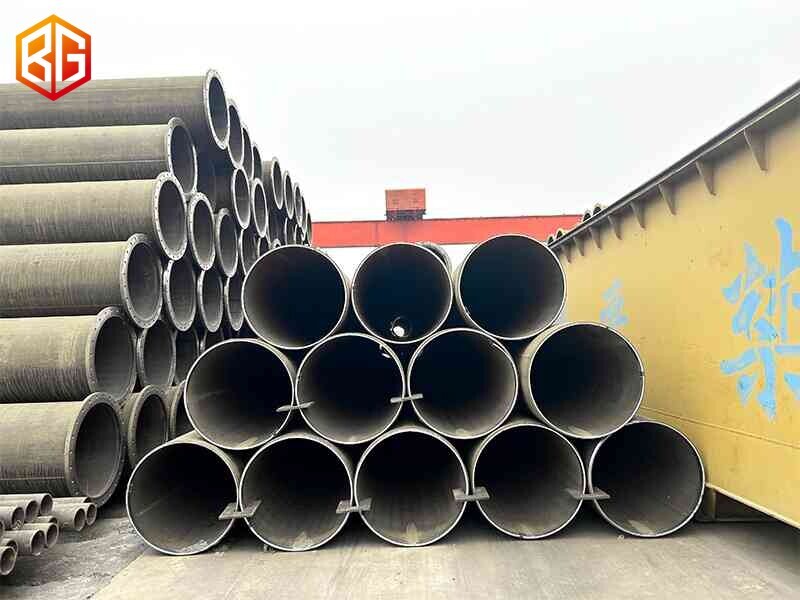NEWS

SSAW (Spiral Submerged Arc Welded) steel pipes used in drainage systems are highly susceptible to corrosion due to continuous exposure to moisture, soil, and various environmental factors. Spiral Seam Submerged Arc Welded Steel Pipe (SSAW) is widely used in drainage piping systems due to its high strength, light weight, and economy. Due to long-term contact with water and soil, the corrosion protection of SSAW steel pipes becomes particularly important. The following are key ways to protect SSAW steel pipes from corrosion.
1. External Coating Protection
The most common method to protect SSAW steel pipes from external corrosion is to apply protective coatings. These coatings prevent the steel surface from direct contact with corrosive elements such as water, chemicals, and salts.Three-layer Polyethylene (3LPE) Coating: This system involves applying an epoxy primer, a copolymer adhesive, and a polyethylene outer layer. It provides excellent corrosion resistance, mechanical protection, and flexibility.
Fusion Bonded Epoxy (FBE) Coating: A layer of epoxy powder is fused to the surface of the steel pipe by heating. This coating is widely used for its durability and excellent corrosion resistance, especially in corrosive environments such as soil and water.
Coal Tar Enamel (CTE) Coating: CTE is an asphalt-based coating that has been used for many years. It provides good corrosion protection, especially for underground installations. It is highly resistant to wet and acidic conditions.
Polyethylene Tape Wrap: In some cases, SSAW pipe is wrapped with polyethylene tape for additional protection. The tape is applied in layers to form a continuous protective barrier that helps prevent corrosion.
2. Internal Coating or Lining
For certain applications, especially in drainage systems that convey corrosive or aggressive fluids, an internal lining or coating can be applied to the SSAW steel pipe. This adds an extra layer of protection to the inside of the pipe against rust and degradation due to contact with the conveyed fluids.
Epoxy Lining: An epoxy coating applied to the inside of the steel pipe helps resist corrosion caused by exposure to water and chemicals. This method is often used in the transport of sewage, wastewater, and other corrosive materials.
3. Cathodic Protection
Cathode protection (CP) is a technique that reduces the rate of corrosion of a metal surface by making it the cathode of an electrochemical cell. It is an important method for protecting steel pipes buried underground or immersed in water.
Sacrificial Anode System: This method uses a more electrochemically active metal (such as zinc, magnesium, or aluminum) in place of the SSAW steel pipe. The sacrificial anode attaches to the pipe and gradually corrodes, providing long-term protection for the steel pipe.
Impressed Current Cathodic Protection (ICCP): In highly corrosive areas, an impressed current system may be used. This method involves applying a low-voltage direct current to the pipe to counteract the electrochemical corrosion process. ICCP is particularly effective for long pipelines or those exposed to severe corrosive conditions.
4. Protective Jackets and Casings
For additional protection, especially in areas where soil conditions are highly corrosive, SSAW steel pipes may be fitted with protective jackets or casings. These are typically made of materials such as plastic, fiberglass, or other corrosion-resistant substances that act as a barrier to physical damage and environmental factors.
5. Proper Installation Practices
Proper installation is critical to ensuring the effectiveness of corrosion protection measures.
Ensure Proper Coating Application: Coatings should be applied according to the manufacturer's specifications, paying attention to surface preparation, curing time, and coating thickness.
Avoid Mechanical Damage: Coatings should be protected from damage during transportation and installation, and pipe joints should be properly sealed.
Insulation of Pipes: In some cases, pipes can be insulated to further prevent corrosion caused by temperature fluctuations or condensation.
6. Regular Inspection and Maintenance
Routine inspection and maintenance are essential to detect early signs of corrosion or damage to protective coatings. Techniques such as ultrasonic testing, visual inspection, and holiday testing (coating defects) should be performed regularly to ensure that the corrosion protection system is operating properly.
7. Monitoring Soil Conditions
In environments where SSAW steel pipe is buried, it is important to monitor the corrosiveness of the soil. Soils with high moisture content, low pH (acidic soils), or high levels of salt or other chemicals can accelerate corrosion. Adjusting protective measures based on these soil conditions can help extend the service life of the steel pipe.
Through the implementation of these anti-corrosion protection measures, it is possible to ensure the long-term stable operation of SSAW steel pipes in the drainage system, reduce maintenance costs and extend service life.
Related Posts
- The 137th Canton Fair opens grandly!
- Ramadan Mubarak to you
- The New Year bell rings, and dreams begin
- Welcome 2025: New Year, New Hope
- We Wish You A Merry Christmas & A Happy New Year
- What are the uses of mild steel
- Why can steel sheet piles be your first choice
- There are several types of common steel sheet piles
- Application areas of color-coated corrugated board
- Cutting method of 304 stainless steel pipe
- Production process of tinplate rolls
- Corrosion Protection Measures for SSAW Steel Pipes for Drainage
Contact Us
MESSAGE
